|
NERC project (Geometrical effects on landslide-tsunamis) |
|
Introduction |

|
|

|
Personal research website of Dr Valentin Heller |
|
Physical model tests |
|
Selected publications |
|
Journals Ruffini, G., Heller, V., Briganti, R. (2021). Numerical characterisation and efficient prediction of landslide-tsunami propagation over a wide range of idealised bathymetries. Coastal Engineering 167:103854 (https://doi.org/10.1016/j.coastaleng.2021.103854). Ruffini, G., Heller, V., Briganti, R. (2019). Numerical modelling of landslide-tsunami propagation in a wide range of idealised water body geometries. Coastal Engineering 153:103518 (https://doi.org/10.1016/j.coastaleng.2019.103518). Heller, V., Bruggemann, M., Spinneken, J., and Rogers, B. (2016). Composite modelling of subaerial landslide-tsunamis in different water body geometries and novel insight into slide and wave kinematics. Coastal Engineering 109(3):20-41 (http://dx.doi.org/10.1016/j.coastaleng.2015.12.004). Heller, V., Spinneken, J. (2015). On the effect of the water body geometry on landslide-tsunamis: Physical insight from laboratory tests and 2D to 3D wave parameter transformation. Coastal Engineering 104(10):113-134 (http://dx.doi.org/10.1016/j.coastaleng.2015.06.006). Heller, V., Spinneken, J. (2013). Improved landslide-tsunami predictions: effects of block model parameters and slide model. Journal of Geophysical Research-Ocean 118(3):1489-1507 (http://dx.doi.org/10.1002/jgrc.20099). Heller, V., Moalemi, M., Kinnear R.D., Adams, R.A. (2012). Geometrical effects on landslide-generated tsunamis. Journal of Waterway, Port, Coastal and Ocean Engineering 138(4):286-298 (http://dx.doi.org/10.1061/(ASCE)WW.1943-5460.0000130). Others Heller, V., Rogers, B. (2015). Subaerial landslide-tsunami generation with a rigid slide in a channel (2D) and basin (3D). SPH benchmark test case 11, online publication, SPH European Research Interest Community SPHERIC website (online http://spheric-sph.org/validation-tests). |
|
Fig. 3. Comparison of relative water surface elevations h/h versus relative time t(g/h)1/2 along the slide axis in 2D at x/h = 3.0 and 22.5 (a,c) and in 3D at r/h = 3.0 and 22.5 (b,d); note the increased scale on the ordinate in (d) |
|
This NERC funded research (NERC NE/000578/1) concerned the detailed investigation of the effect of the water body geometry on landslide-tsunami features and significantly improved the reliability of landslide-tsunami (impulse wave) prediction. The project involved the composite modelling approach (physical and numerical model tests combined) and successfully addressed the following two main objectives: (a) to obtain a set of generic empirical formulae including the effect of the water body geometry and (b) to provide high quality experimental benchmark test cases for numerical simulations. |
|
Fig. 1. Series of images of slide impact and tsunami generation in a 20 m x 12 m large wave basin (3D); the time interval from (b) onwards is 0.2 s |
|
Fig. 2. Drawing of a rigid slide with integrated force sensors and a total mass of 83 kg |
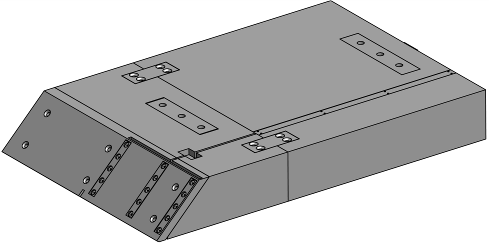
|
Fig. 8. Dr Fuchs, ETH Zurich, presents his work at the short course in Chengdu, China |

|
High quality physical model tests in the two most common water body geometries (i) wave flume (2D) and (ii) wave basin (3D, Figure 1) were conducted. The tests included a unique combination of measurements such as forces on the slide front (Figure 2), which were measured for the first time and are important to calibrate/validate numerical simulations in coastal engineering or marine renewable energy applications. The 3D waves were up to a factor of 17 smaller than 2D waves. This point is illustrated in Figure 3 showing the water surface displacement due to a rigid slide impacting into 2D (a,c) and 3D (b,d). Note that the scale on the ordinate in Figure 3(d) is increased by a factor of 10. New empirical equations for the prediction of 3D landslide-tsunamis were derived and a novel method to transform tsunamis measured in 2D to 3D was introduced. Figure 4 shows as an example the diagram used to transform the wave amplitude. This directly increases the reliability of landslide-tsunami hazard assessment in fjords, lakes, reservoirs and the sea. |
|
Dissemination of results |

|
The results and high quality benchmark cases are currently widely disseminated in the form of peer-review articles including Heller et al. (2016) and Heller and Spinneken (2015), on webpages and at a conference. A short course about landslide generated impulse waves, including some results of the present work, was hold at the IAHR World Congress in Chengdu in collaboration with ETH Zurich and The University of Manchester. Figure 8 shows one of the guest lecturers and some of the participants of this short course. Further, a benchmark case test has been published on the SPHERIC website (Heller and Rogers 2015). Another workshop has recently been given at the Swiss Federal Office of Energy in collaboration with ETH Zurich and the Swiss Committee on Dams, Ittigen, Switzerland, 25.11.2019 |

|
Last modified: 02.07.2021 |
|
The numerical simulations were conducted with the recently released open source code DualSPHysics, which is based on the Smoothed Particle Hydrodynamics SPH method. The simulations in Fig. 5 were calibrated and validated with the high quality 2D and 3D laboratory data and intermediate water body geometries between 2D and 3D were then purely numerically investigated. This gave further physical insight into the effect of the water body geometry and investigated the potential of open source codes for landslide-tsunami hazard assessment. The results are published in Heller et al. (2016). |
|
Fig. 5. This test in the wave flume (2D) geometry was conducted with DualSPHysics |
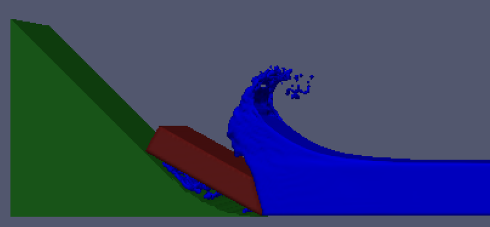
|
Numerical model tests |
|
Fig. 4. 2D to 3D wave parameter transformation: wave amplitude ratio a3D,1/a2D,1 versus a product of the relative distance (r/h) and the slide impact characteristics given by F, S and M; the results are compared with the small-scale pre-study Heller et al. (2012) |
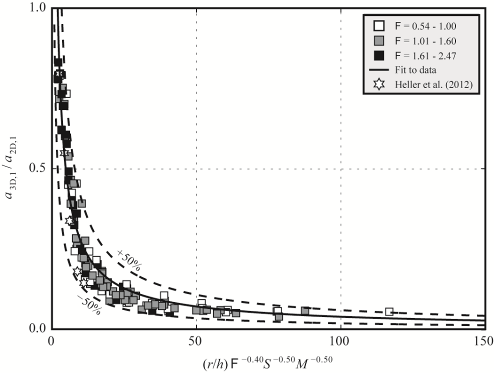
|
Fig. 6. Lateral wave decay of the wave height H for a type of idealised landslide-tsunamis for all investigated distances and geometries in function of the water body side angle. bí is the length of the interface between generation and propagation zones and† the tsunami propagation angle. The numerical data are compared with the developed equations. |
|
Generic empirical equations based on SWASH and ANN (Dr Ruffini) |
|
Further numerical simulations were performed with the numerical model SWASH based on the non-hydrostatic non-linear shallow water equations. A wide range of idealised landslide-tsunamis were simulated to study their propagation in idealised diverging water body geometries. The main parameter linking the wave decay with the propagation distance in every geometry was found to be the wavefront length lw. This variable represents the length of the circumference arc of the tsunami front. By using Greenís law adapted with the wavefront length and empirical terms, equations to predict the tsunami features (Fig. 6) at any desired point based on the initial landslide-tsunami and the water body characteristics were derived. These results are shown in Ruffini et al. (2019) together with the computation procedure applied to a real case. |
|
The effect of the water body geometry |
|
The effect of the bathymetry |
|
Numerical simulations were performed with SWASH to analyse the effect of the bathymetry on landslide-tsunamis. Idealised landslide-tsunamis were simulated in beach bathymetries (Fig. 7a), submerged positive and negative Gaussian bathymetric features (Fig. 7b) and step bathymetries (Fig. 7c). 184 numerical tests were analysed to develop an Artificial Neural Network (the developed code can be downloaded here) and equations based on regression analysis able to predict the wave height and amplitude in every bathymetry. This allowed to define a prediction method that would consider both the effect of the geometry and bathymetry for landslide-tsunami hazard assessment. This new method was validated with the 2014 Lake Askja landslide-tsunami as shown in Ruffini et al. (2021). |
|
Fig. 7. Schematic representations of the three investigated bathymetries with h0 the initial water depth, hf the water depth at the bathymetry and Lf the length of the bathymetry for (a) linear beach, (b) Gaussian bathymetric features and (c) step bathymetries. |
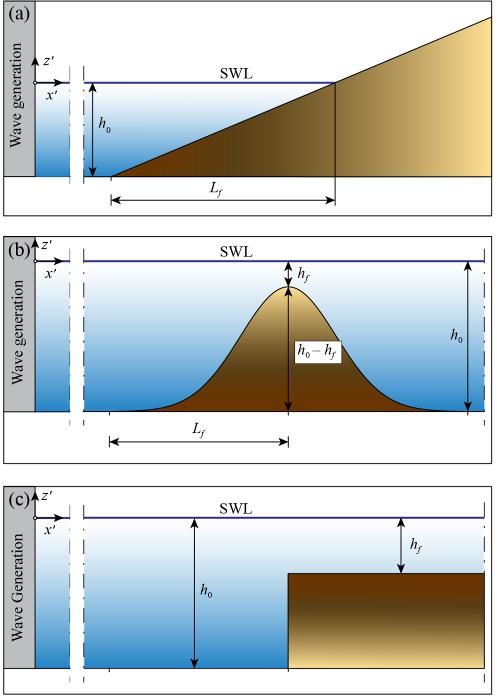
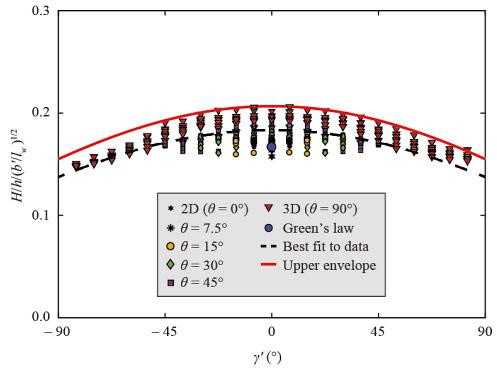
|
|